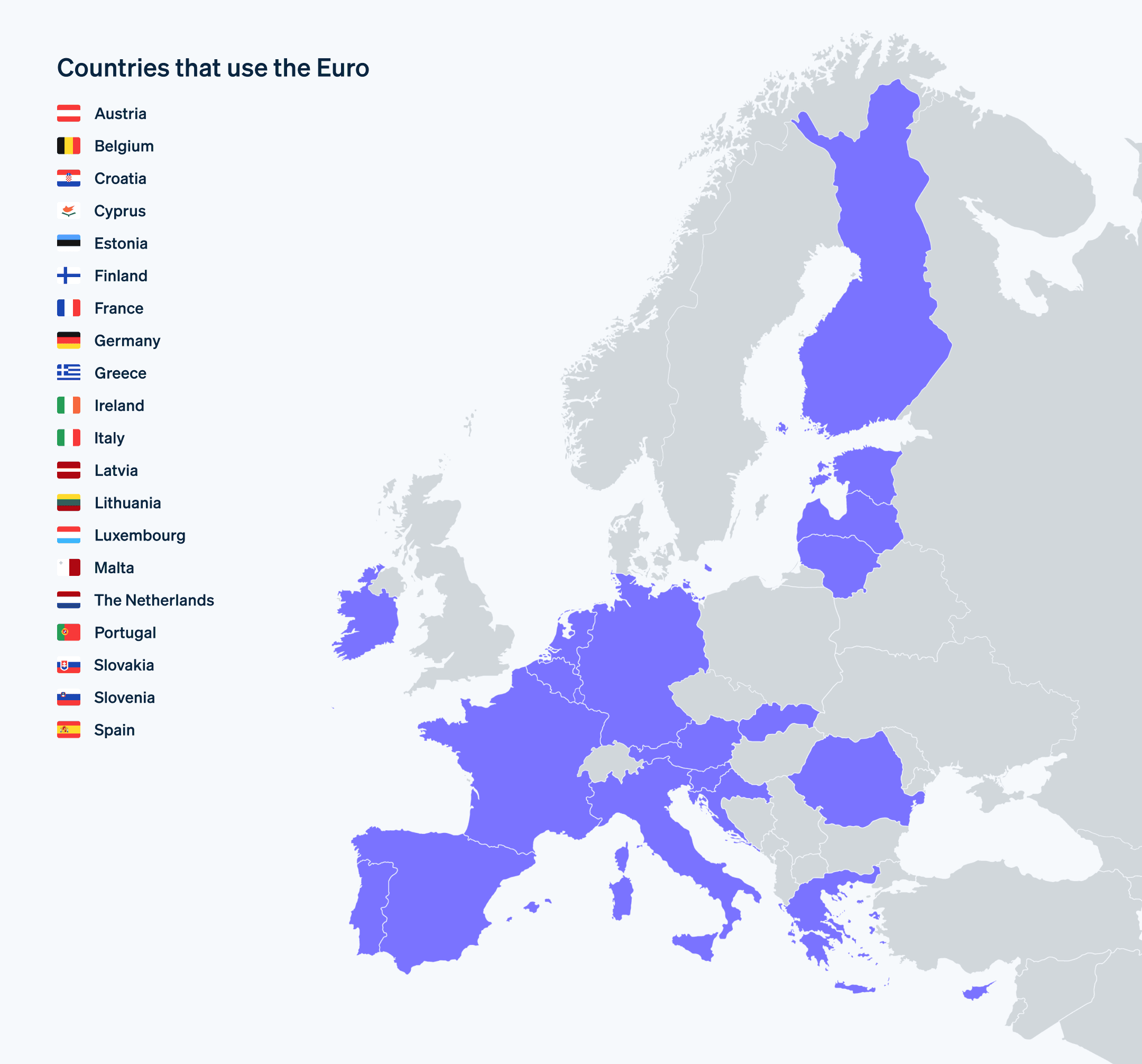As of 2022, the euro has been the world's second-most traded currency and it has a major influence on the global economy. It gives businesses and countries a meaningful alternative to the US dollar, and promotes competition and stability within foreign exchange markets. The strength of the euro stems from the eurozone, an economically powerful collective of nations which all use the euro.
Businesses within the eurozone benefit from using a single currency. It makes trade easier and gets rid of the need for currency conversion. For international businesses, operating in euros reduces exposure to risks surrounding exchange rates. A strong euro grows the European Union's global presence, allowing it to advocate for its economic interests and help to shape global financial regulations.
This guide will cover a brief history of the euro and where it's currently used.
What's in this article?
- History of the euro
- Importance of the euro in the world economy
- Which countries use the euro?
History of the euro
The euro is the official currency of the eurozone, which includes 20 of the 27 EU member states. The process of creating a single European currency began in earnest with the Werner Report published in 1970, which had the failed goal of creating a monetary union by 1980. The Maastricht Treaty, signed in 1992, set the formal criteria for the adoption of a single currency. And in 1994, the European Monetary Institute was established to strengthen cooperation between the EU's central banks and to prepare for the European Central Bank (ECB) and the euro.
On 1 January 1999, the European Union introduced the euro as an "invisible" currency for electronic payments and accounting purposes, while continuing to use national currencies for cash transactions. Euro banknotes and coins began circulating on 1 January 2002, replacing the old currencies of 12 member states and marking the biggest cash changeover in history. The old national currencies ceased to be legal tender shortly thereafter.
However, the global financial crisis of 2008 and subsequent European debt crises exposed weaknesses in the eurozone's economic architecture. The EU introduced measures such as the European Stability Mechanism (ESM) to provide financial stability and assistance to member states in financial distress.
The eurozone expanded in the years that followed as new EU members met the economic Maastricht criteria for entry, with Slovenia joining in 2007, Malta in 2008, Slovakia in 2009, Estonia in 2011, Latvia in 2014 and Lithuania in 2015. Croatia was the most recent addition, adopting the euro in 2023.
Importance of the euro in the world economy
Facilitates trade: The euro simplifies trade among the member countries of the eurozone and with the rest of the world. By eliminating currency exchange risks and costs, the euro creates more transparent pricing and reduces transaction expenses.
Promotes economic integration: The adoption of the euro has led to more synchronised economic policies and regulations among its member states. This integration has created a more stable and predictable economic environment within Europe, which is beneficial for business planning and investments.
Acts as a global reserve currency: The euro is one of the major reserve currencies in the world, held by several central banks and financial institutions as part of their foreign exchange reserves. This gives the euro influence over global exchange rates and monetary policies.
Influences global markets: The eurozone's monetary policy, governed by the ECB, has a major impact on global financial markets. Decisions regarding interest rates or quantitative easing in the eurozone can affect global capital flows, investment decisions and economic conditions beyond Europe.
Promotes EU cooperation: The euro is a symbol of European unity and identity, and its management requires close cooperation among the member states. This necessary cooperation promotes political integration and stability in the region, which is especially important in times of economic or political turmoil.
Creates attractive investment opportunities: The eurozone presents a large and attractive market for investments. The euro offers investors the advantage of a wide, integrated market that avoids the risk associated with currency fluctuations – which might otherwise exist between smaller, separate national markets.
Which countries use the euro?
As of May 2024, the euro is the official currency of 20 European countries, with around 341 million people using it every day. These countries collectively form what is known as the eurozone:
Austria, Belgium, Croatia, Cyprus, Estonia, Finland, France, Germany, Greece, Ireland, Italy, Latvia, Lithuania, Luxembourg, Malta, The Netherlands, Portugal, Slovakia, Slovenia, Spain.

Despite not belonging to the EU, microstates and city-states in Europe also use the euro because of their proximity to eurozone countries. The euro is also used by countries that have applied for EU membership but are not yet members. These areas include:
Andorra: Andorra adopted the euro in 2002 and made it the country’s official currency in 2011.
Kosovo: Kosovo adopted the euro as its official currency in 2002.
Monaco: Monaco adopted the euro as its official currency in 2002.
Montenegro: Montenegro adopted the euro as its official currency in 2002.
San Marino: San Marino adopted the euro as its official currency in 2002.
Vatican City: Vatican City adopted the euro as its official currency in 2002.
In these places, the euro facilitates economic transactions and supports the local economy by associating it with a strong and stable currency.
The content in this article is for general information and education purposes only and should not be construed as legal or tax advice. Stripe does not warrant or guarantee the accuracy, completeness, adequacy, or currency of the information in the article. You should seek the advice of a competent lawyer or accountant licensed to practise in your jurisdiction for advice on your particular situation.